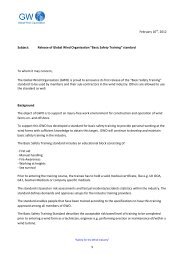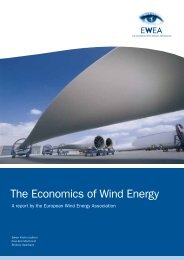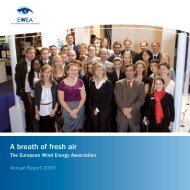Offshore Electricity Infrastructure in Europe - European Wind Energy ...
Offshore Electricity Infrastructure in Europe - European Wind Energy ...
Offshore Electricity Infrastructure in Europe - European Wind Energy ...
Create successful ePaper yourself
Turn your PDF publications into a flip-book with our unique Google optimized e-Paper software.
Annex d – details of results<br />
FiGuRe 13.13: maximum distance between hubs FOR asymmetRic w<strong>in</strong>d FaRm hubs capacity - diFFeRent pROFiles OF pRice<br />
diFFeRence (30% tO cOuntRy a, 50% tO eitheR cOuntRy, and 70% tO cOuntRy b) [€/mwh] (<strong>in</strong>teRcOnnectOR capacity OF<br />
500 mw, w<strong>in</strong>d FaRm capacity <strong>in</strong> cOuntRy 2 is twice the size OF the w<strong>in</strong>d FaRm <strong>in</strong> cOuntRy a)<br />
M<strong>in</strong>imum distance<br />
between hubs (km)<br />
400<br />
300<br />
200<br />
100<br />
0<br />
100 200 300 400 500 600 700 800 900 1,000<br />
30%<br />
50%<br />
which is compared), the more <strong>in</strong>frastructure costs will<br />
be saved by <strong>in</strong>terconnect<strong>in</strong>g hubs. The maximum beneficial<br />
distance between hubs therefore <strong>in</strong>creases with<br />
<strong>in</strong>creas<strong>in</strong>g direct <strong>in</strong>terconnector length (Figure 13.11).<br />
Impact of absolute price difference<br />
The higher the absolute price difference between the<br />
countries, the more the trade of electricity becomes<br />
important and the less the <strong>in</strong>terconnector cable<br />
should be constra<strong>in</strong>ed. For higher absolute price differences,<br />
the reduction <strong>in</strong> <strong>in</strong>frastructure costs due<br />
to the reduced cable length must be higher to cover<br />
the reduction <strong>in</strong> system benefits. The maximum distance<br />
between hubs <strong>in</strong> these cases is therefore lower<br />
(Figure 13.12).<br />
<strong>Electricity</strong> price profiles and w<strong>in</strong>d-price<br />
correlations<br />
• Unbalanced price profiles have no impact<br />
If the price difference is not balanced, which here<br />
means that the price is most of the time (>50% of<br />
the time) lower <strong>in</strong> one country, one of the legs (the<br />
one connect<strong>in</strong>g the country with lower prices) is not<br />
often loaded and <strong>in</strong>frastructure rema<strong>in</strong>s unused<br />
(the leg connect<strong>in</strong>g the country with lower prices).<br />
However, as the constra<strong>in</strong>ts on the cables are <strong>in</strong>dependent<br />
on the direction of the price difference<br />
W<strong>in</strong>d farm hub capacity (on either side) (MW)<br />
70%<br />
when the cable capacities are identical, this has<br />
no effect on the break—even distance. The constra<strong>in</strong>ts<br />
can be partly relieved by dimension<strong>in</strong>g one<br />
leg bigger and the other leg smaller.<br />
• Correlation between w<strong>in</strong>d and price imbalance <strong>in</strong>creases<br />
the impact.<br />
• As before with the tee-<strong>in</strong> solutions (paragraph<br />
4.4.1), a correlation between the w<strong>in</strong>d power production<br />
and the price imbalance has a negative<br />
effect on the economics of <strong>in</strong>tegrated solutions<br />
compared to the bus<strong>in</strong>ess as usual case. Similarly,<br />
an <strong>in</strong>verse correlation has a positive effect.<br />
Impact of asymmetric w<strong>in</strong>d farm hub<br />
capacities<br />
In Figure 13.13 the effect of asymmetric w<strong>in</strong>d farm<br />
hub capacities is analysed. The w<strong>in</strong>d farm hub <strong>in</strong> country<br />
A is 50% smaller than the w<strong>in</strong>d farm hub <strong>in</strong> country<br />
B. The w<strong>in</strong>d farm connection cable <strong>in</strong> country B is thus<br />
double the size of the connection cable <strong>in</strong> country A so<br />
that w<strong>in</strong>d power from both hubs can flow to the country<br />
with the highest prices most of the time (country<br />
B). Figure 13.13 confirms that when prices are more<br />
often higher <strong>in</strong> country B (30% of price difference balanced<br />
to country A), the trade is less constra<strong>in</strong>ed<br />
which leads to a higher maximum distance between<br />
hubs.<br />
136 <strong>Offshore</strong>Grid – F<strong>in</strong>al Report









